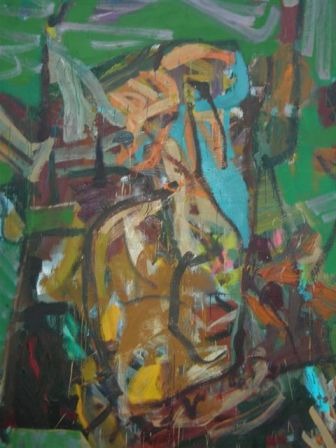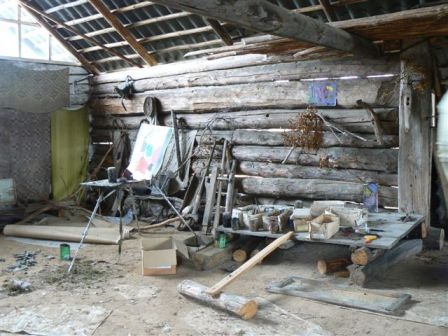IN MEMORIAM OF A.VAITKŪNAS. INHABITANTS OF FORT AND FOREST 0
Aušra Barzdukaitė-Vaitkūnienė
www.kamane.lt , 2007 11 03
A.Vaitkūnas. “Fort Inhabitant”, canvas, oil, 198x140 cm, 2001-2002
A.Vaitkūnas. “Forest Inhabitant”, canvas, oil, 198x140 cm, 2003
Summer workshop of Arūnas in Margionys stack-yard.
I call the works painted by Arūnas in 2000-2003 existential – psychological works. He created some canvases intensively in Margionys during the summer and others – in winter at his workshop in Kaunas. He painted interiors with alters at St. George Church in Kaunas. Sacral interiors of the forlorn church are without a human-being. The being of him is only implicit. Another force reigns in majestic interiors – it leaves a trace through the intensity of a stroke or a stern selection of colours.
Other works created during that period are abstract psychological studies of a human-being. Arūnas has painted a number of excellent portraits during the entire period of creation. One portrait “Portrait of J.Mikutis” has been purchased by Silkeborg art museum in Denmark as the best example of expressionist painting.
In 2000-2003 Arūnas took interest in figurative meaning in painting. The coming back of contemporary painting to the figurativeness became prominent in the world context of painting. However, as I’ve mentioned, Arūnas painted portraits during all his live in various periods. Canvases created in 2000-2003 are generalised portraits even though particular prototypes of them were created in the real environment. These are psychological portraits of society outcasts, closer to figurative compositions. No matter where the person lives, in the countryside or in the city, the painter discovers the painful fate of his personages and generalises it in the paintings, where truths of wild existence are disclosed.
Arūnas was sensitive and merciful. He was moved deeply by even the most desperate drunkard lying in the street. “You may never know in what situation you may find yourself once”, he used to state then. (…)
When we lived in the countryside in summer, there appeared much farm work. Arūnas was never short of help. Local men used to help him willingly. They considered him a very down-to-earth professor. He had some faithful helpers. They were sitting under the linden tree in the morning while we were still asleep and were smoking, waiting until the master would treat them with coffee. Later they used to ask diffidently: “Arūnas, maybe a small one?” Returning to the cottage, he used to mumble displeased but poured a small glass of a beverage saying: “It is difficult for them, and we may not change anything”. (…)
Life experience, heard stories turning into plastic of painting – this is the grammar and vocabulary of an artist’s language. These stories and communication used to excite Arūnas’ imagination. This was how the works “Fort Inhabitant” appeared in 2001-2002 and “Forest Inhabitant” in 2003. These works have been painted in Kaunas, in the workshop. However, the idea is the same – human existence, the fall and desperate situation.
The composition of “Fort Inhabitant” is static. A figure with a deformed face crucified by disasters of life is in the centre. The canvas was repainted many times, it obtained the shape of an old masonry covered by time and experience. A man without a place, a house taking all strokes of life. He is also prepared to defend using the last effort as he is a fort inhabitant. The active red background is painful, the symbol of pain, it encourages not to succumb.
Static figure, chopped or crucified hands contradict to the active colour of the background and testify about resignation. The face deformation, which appears when the bottom of life is reached, is the axis of the painting in which the conflict of the background, environment and static figure interact.
“Forest Inhabitant” is a particular character with all kinds of experience. His situation is slightly different. The inhabitant of village and nature has been painted upside down. He is not so conscious, more animal-like, his pain has been shared with nature. The colours of the canvas are more transparent, the dominating green colour smoothes out all tensions.
“Forest Inhabitant” is still a man and not a man any more. It is something grown into moss organically. The reason and consequence. There is some resignation in this work as well. However, it feels natural and not painful.











